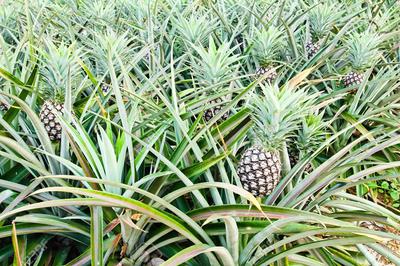BUY UGANDA VANILLA BEANS SOYBEAN OIL
How to grow PINEAPPLES in Uganda

PINEAPPLES in Uganda
The pineapple is a tropical and sub tropical fruit grown in many African countries.
Locally the fruit is known as “Enanansi”. The fruit is trade-able and generates a lot of income for farmers who grow it.
In Uganda pineapples are mainly grown south of Lake Kyoga and in western Uganda.
Common Pineapple cultivars grown in Uganda
Smooth cayenne; it’s by far the most important cultivar throughout the tropics.
Queens; this cultivar is smallest and sweeter than the cayenne.
The Red Spanish; it’s a semi spineless cultivar; its fruits are intermediate of smooth cayenne and Red Spanish.
Contact us here to buy fresh Pineapple and Pineapple Suckers in Uganda
Soil requirements for Pineapple growing
Pineapples grow well on well drained fertile sandy loam soils. The soils should be rich in humus with a pH range of 4.5 to 5.5.
How to Propagate Pineapples on your farm
Pineapples are vegetatively propagated using the following pineapple plant parts.
Suckers; these are off shoots and take about 17 months to fruit.
Slips; these are under growing of a pineapple plant and they take about 20 months to fruit.
Crowns; this is the top spike or leafy part of a pineapple; it takes about22 to 24 months to fruit.
Contact us here to buy fresh Pineapple and Pineapple Suckers in Uganda
How to plant Pineapples in Uganda
Crowns are currently the preferred planting material used by Ugandan farmers.
These are twisted from the fruit at the time of harvest or after eating the pineapple.
The wound on the crown i.e. the downer part is allowed to dry (cure) for 1 to 2 weeks.
Alternatively the crowns can be trimmed to remove the fruit tissue high in sugars and then dipped in a fungicide for direct planting.
A spacing of 2ft (60cm) between the rows, 1 ft (30cm) between the plants and 4ft (120cm) between adjacent double rows.
And this will give approximately 36,250 plants/ha mark your rows with a string and pegs then dig shallow holes of 7 to 10 cm deep in the ground and then plant the pedal part of the crown and firm the soil around it. Plant the propagules at the ground level and later ridge to help provide a deep bed for better root growth.
Fertilizers; Nitrogen is the nutrient most used by pineapples.
It can be applied at the rate of 50 kg per hectare by top dressing. Potassium is also essential as its deficiency would lead to poor quality fruits.
The best method to apply potassium is by broad casting into holes before planting.
Weed off your pineapple field to prevent host of disease causing pests less the competition for nutrients with your main crop.
Contact us here to buy fresh Pineapple and Pineapple Suckers in Uganda
How Best to Harvest Pineapple
Pineapples should mature in 15 to 24 months depending on the planting material used.
When harvesting its best to cut rather than to break the fruit from the stalk.
Under adequate management the main crop should yield about 70 tons per hectare.
About the Pineapple Market in Uganda
Pineapples do have a wider market on local markets shelves, supermarket fruit and vegetable sections and even processing companies.
The fruit is also exported to the neighboring countries like Rwanda and Sudan.
Contact us here to buy fresh Pineapple and Pineapple Suckers in Uganda
Quick Tips for growing Pineapples in Uganda
- Clear up land meant for planting by deep cultivation.
- Treat the crowns with fungicide and insecticide before planting.
- Mark your field using the 2ft and 1ft spacing for planting.
- Place the crowns 3cm deep in to the field and gently firm with soil.
- Spray the plantings with foliar fungicide and pesticide.
- Also water a bit the crowns for proper growth.
- In about 15 to 24 months you will be able to harvest your pineapple fruits.
Contact us here to buy fresh Pineapple and Pineapple Suckers in Uganda
Join in and write your own page! It's easy to do. How? Simply click here to return to Plants Guide.
If you haven't yet found what you were looking for or you need detailed information about the subject matter on this page then... feel free to ask our business travel consultants. |




